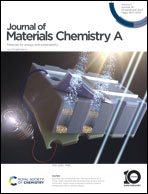Towards durable Li-hybrid flow batteries: composite membrane development, cell performance, and perspective†
Abstract
Effective solid-state electrolytes (SSEs) are now of major interest to the battery society owing to their improved safety and wide applicability. Although polymer-inorganic SSEs are very promising because of the beneficial combination of ionic conductivity and flexibility, many issues remain to be solved: from the fabrication technology to the fundamental questions of conduction mechanisms. By developing a Li1.3Al0.3Ti1.7(PO4)3–poly(vinylidene fluoride) (LATP+PVdF) composite membrane, we overcome microstructural issues by tailoring the fabrication route to be adopted for lithium-metal hybrid flow batteries (Li-HFBs), which are the next-generation energy storage concept. We suppress the membrane's permeability toward redox-active molecules, (2,2,6,6-tetramethylpiperidin-1-yl)oxyl (TEMPO), from 6.6 to 0.86 × 10−7 cm2 min−1, maintaining the composite's ionic conductivity at the acceptable level (>10−4 S cm−1). The Li-TEMPO hybrid flow cell equipped with the upgraded membrane exhibits high initial capacity (∼93%) and stable coulombic efficiency (∼95%) for 100 cycles, while the Li-HFB's capacity decay rate is reduced to 0.39% h−1 (vs. 0.79% h−1 for the original membrane). For the first time, we experimentally prove a strong impact of PVdF's microstructure and ceramic agglomeration on permeability, as well as the active involvement of LATP in ion-conductivity processes. The proposed conductive, dense, and stable composite membranes are promising for implementation in Li-HFBs and beyond.



 Please wait while we load your content...
Please wait while we load your content...